The carboxymethyl tamarind kernel powder (CMTKP) market is projected to grow from USD 18.8 million in 2025 to USD 34 million by 2035. The carboxymethyl tamarind kernel powder market is positioned for steady expansion as manufacturers across food processing, pharmaceuticals, and industrial sectors increasingly adopt bio-based hydrocolloids that offer functional thickening, stabilizing, and binding capabilities. CMTKP is derived from tamarind seeds and undergoes carboxymethylation to enhance solubility, viscosity control, and compatibility with diverse formulation environments. This positions the ingredient as an attractive alternative to synthetic and modified starch-based additives, particularly in applications requiring clean label alignment, controlled hydration behavior, and natural ingredient sourcing.
In the food and beverage sector, CMTKP is gaining use in sauces, beverages, bakery fillings, dairy analogs, and ready-to-cook products, where it provides texture enhancement and uniform suspension stability. In pharmaceutical formulations, the material supports controlled release matrices and disintegration behavior in tablet manufacturing. Meanwhile, industrial applications such as textile printing pastes, paper sizing, and adhesive formulations benefit from its film-forming and rheology-modifying characteristics. Market adoption is being strengthened by the shift toward plant-based and allergen-safe ingredients, along with increased research into improving CMTKP batch consistency, purity levels, and viscosity grades. Suppliers offering standardized quality control and scalable supply partnerships are well-positioned to capture growth opportunities as demand for natural hydrocolloids continues to rise across global production environments.
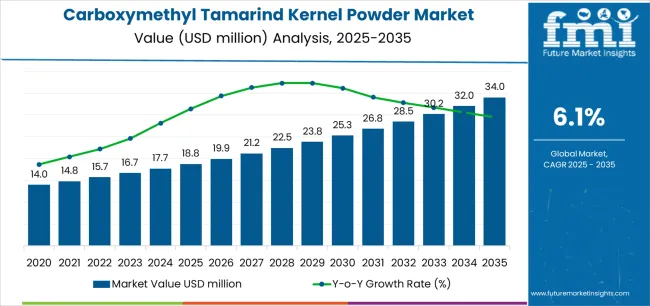
The market benefits from expanding clean label activities across food production, pharmaceutical manufacturing, and industrial sectors, driving demand for sophisticated hydrocolloid technologies that enable enhanced product performance and extended shelf stability. Growing emphasis on natural ingredients and processing optimization creates opportunities for manufacturers offering validated tamarind-based systems with comprehensive application expertise and performance assurance capabilities.
Technology advancement influences market evolution through integration of advanced processing methods, enhanced purification techniques, and modified derivative approaches that improve powder performance and application outcomes. Manufacturers focus on developing hydrocolloid solutions that accommodate varying viscosity requirements, pH conditions, and temperature specifications while maintaining consistent thickening performance throughout extended storage periods.
The carboxymethyl tamarind kernel powder market demonstrates strong growth fundamentals driven by expanding food processing activities, pharmaceutical development programs, and increasing demand for natural hydrocolloid technologies across multiple industrial sectors and formulation applications.
The first half of the decade (2025-2030) will witness market growth from USD 18.8 million to approximately USD 24.2 million, adding USD 5.4 million in value, representing 36% of the total forecast period expansion. This phase will be characterized by rapid adoption of natural hydrocolloid technologies, driven by clean label initiatives and increasing demand for plant-based functional ingredients across food processing applications.
The latter half (2030-2035) will experience accelerated growth from USD 24.2 million to USD 34 million, representing an addition of USD 9.8 million or 64% of the decade's expansion. This period will be defined by mass market penetration of modified tamarind derivatives, integration with advanced processing technologies, and seamless compatibility with existing formulation systems.
| Period | Primary Revenue Buckets | Share | Notes |
|---|---|---|---|
| Today | Food applications | 48% | Bakery products, dairy systems |
| Pharmaceutical formulations | 26% | Tablet binding, capsule systems | |
| Industrial applications | 16% | Adhesives, textile processing | |
| Cosmetics and personal care | 10% | Skin care, hair products | |
| Future (3-5 yrs) | Food processing expansion | 44-48% | Clean label initiatives, natural thickeners |
| Pharmaceutical growth | 28-32% | Modified release systems, specialty formulations | |
| Industrial diversification | 18-22% | Advanced adhesives, paper coating | |
| Personal care innovation | 8-12% | Premium formulations, natural cosmetics |
| Metric | Value |
|---|---|
| Market Value (2025) | USD 18.8 million |
| Market Forecast (2035) | USD 34 million |
| Growth Rate | 6.1% CAGR |
| Leading Application | Food Applications |
| Primary End-Use | Food Processing |
The market demonstrates strong fundamentals with food applications capturing dominant share through advanced thickening capabilities and natural ingredient optimization. Food processing operations drive primary demand, supported by increasing clean label development and natural ingredient initiatives. Geographic distribution remains concentrated in developed markets with established food processing infrastructure, while emerging economies show accelerating adoption rates driven by industrial development programs and rising ingredient technology investment.
Primary Classification: The market segments by solubility type into hot water soluble and cold water soluble configurations, representing evolution from traditional gum systems to sophisticated modified hydrocolloids for comprehensive viscosity enhancement and processing optimization.
Secondary Classification: Application segmentation divides the market into food applications, pharmaceutical formulations, cosmetics and personal care, and industrial applications, reflecting distinct requirements for viscosity performance, regulatory compliance, and processing specifications.
Tertiary Classification: End-use segmentation covers food processing, pharmaceutical manufacturing, cosmetics production, and industrial facilities, while grade classifications span food grade, pharmaceutical grade, and industrial grade applications.
Regional Classification: Geographic distribution covers North America, Latin America, Western Europe, Eastern Europe, Asia Pacific, South Asia, and Middle East & Africa, with developed markets leading adoption while emerging economies show accelerating growth patterns driven by food processing expansion programs.
The segmentation structure reveals technology progression from traditional tamarind kernel systems toward sophisticated carboxymethyl derivatives with enhanced performance capabilities, while application diversity spans from basic thickening improvement to specialized high-performance procedures requiring precise viscosity control solutions.
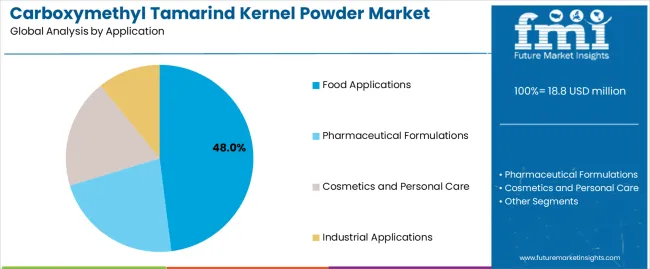
Market Position: Food applications command the leading position in the carboxymethyl tamarind kernel powder market with 48% market share through proven thickening technologies, including enhanced viscosity control, reliable processing capabilities, and formulation optimization that enable food manufacturers to achieve optimal product performance across diverse bakery and dairy environments.
Value Drivers: The segment benefits from manufacturer preference for natural hydrocolloid systems that provide consistent thickening performance, processing reliability, and ingredient flexibility without requiring extensive reformulation. Advanced powder processing features enable enhanced viscosity control, precise texture management, and integration with existing food systems, where performance consistency and ingredient naturalness represent critical manufacturing requirements.
Competitive Advantages: Food applications differentiate through proven processing reliability, comprehensive ingredient specifications, and integration with established food systems that enhance formulation effectiveness while maintaining optimal performance standards suitable for diverse food processing applications.
Key market characteristics:
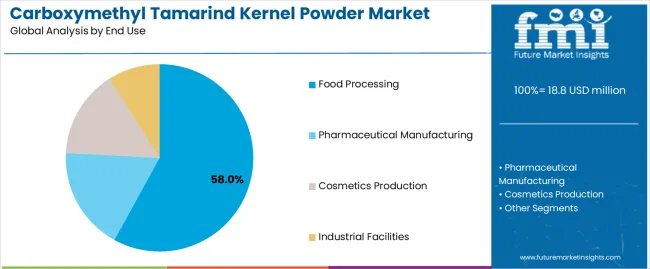
Market Context: Food processing operations dominate the market with a 58% share, reflecting the primary demand source for carboxymethyl tamarind kernel powder technology in product formulation and texture enhancement.
Business Model Advantages: Food Processing provides direct market demand for standardized hydrocolloid systems, driving volume production and cost optimization while maintaining performance consistency and regulatory compliance requirements.
Operational Benefits: Food Processing applications include texture optimization, viscosity enhancement, and product stability assurance that drive consistent demand for powder systems while providing access to latest thickening technologies.
| Category | Factor | Impact | Why It Matters |
|---|---|---|---|
| Driver | Clean label movement & natural ingredient demand (organic formulations, plant-based products) | ★★★★★ | Growing clean label market requires natural hydrocolloid systems with enhanced thickening capabilities and processing properties proven effective across food applications. |
| Driver | Food processing expansion & texture enhancement (bakery development, dairy innovations) | ★★★★★ | Transforms ingredient requirements from "basic thickening" to "precision viscosity control"; manufacturers that offer advanced powder systems and processing features gain competitive advantage. |
| Driver | Pharmaceutical development & natural excipients (modified release, specialty formulations) | ★★★★☆ | Modern pharmaceutical facilities need sophisticated, validated hydrocolloid systems; demand for certified and compliant natural excipients expanding addressable market. |
| Restraint | High processing cost & technical complexity (especially for pharmaceutical grade applications) | ★★★★☆ | Smaller food processors defer ingredient upgrades; increases cost sensitivity and slows advanced technology adoption in price-conscious markets. |
| Restraint | Competition from synthetic hydrocolloids & alternative thickeners (traditional gums, modified starches) | ★★★☆☆ | Alternative thickening technologies limit natural hydrocolloid adoption and increase competitive pressure, potentially constraining growth in conventional applications. |
| Trend | Advanced processing integration & modified derivatives (enhanced functionality, specialized grades) | ★★★★★ | Advanced powder properties, performance optimization, and multi-functional capabilities transform operations; processing advancement and derivative development become core value propositions. |
| Trend | Application diversification & specialty formulations (cosmetics integration, industrial expansion) | ★★★★☆ | Specialized hydrocolloid systems for specific applications and performance protocols; targeted formulation and customized functionality capabilities drive competition toward application-specific solutions. |
The carboxymethyl tamarind kernel powder market demonstrates varied regional dynamics with Growth Leaders including China (8.2% growth rate) and India (7.6% growth rate) driving expansion through food processing development and natural ingredient initiatives. Steady Performers encompass Germany (7% growth rate), Brazil (6.4% growth rate), and developed regions, benefiting from established food processing infrastructure and clean label sector growth. Mature Markets feature United States (5.8% growth rate), United Kingdom (5.2% growth rate), and Japan (4.6% growth rate), where food innovation and natural ingredient requirements support consistent growth patterns.
Regional synthesis reveals Asia Pacific markets leading adoption through food processing expansion and natural ingredient development, while European countries maintain steady expansion supported by clean label integration and technology investment. North American markets show strong growth driven by natural ingredient applications and food processing modernization trends.
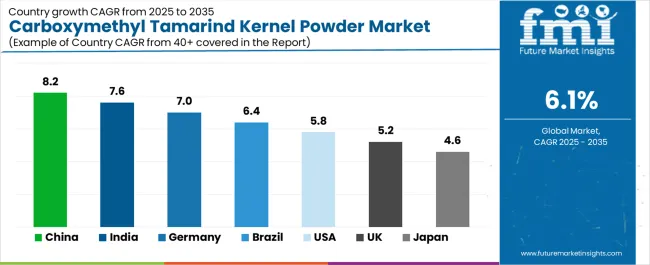
| Country | 2025-2035 Growth | How to win | What to watch out |
|---|---|---|---|
| China | 8.2% | Focus on cost-effective processing solutions | Regulatory changes; local competition |
| India | 7.6% | Lead with natural ingredient applications | Import restrictions; infrastructure barriers |
| Germany | 7% | Provide premium hydrocolloid systems | Over-regulation; lengthy approvals |
| Brazil | 6.4% | Offer value-oriented solutions | Currency fluctuations; import duties |
| United States | 5.8% | Push clean label integration | Compliance costs; scaling challenges |
| United Kingdom | 5.2% | Focus on specialty applications | Economic impacts; funding constraints |
| Japan | 4.6% | Emphasize precision manufacturing | Traditional preferences; adoption rates |

China establishes fastest market growth through aggressive food processing development programs and comprehensive natural ingredient facility expansion, integrating advanced carboxymethyl tamarind kernel powder systems as standard components in food manufacturing and pharmaceutical production facilities. The country's 8.2% growth rate reflects government initiatives promoting food safety modernization and domestic hydrocolloid capabilities that mandate use of natural thickening systems in food processing and pharmaceutical facilities. Growth concentrates in major industrial regions, including Beijing, Shanghai, and Guangzhou, where food processing development showcases integrated powder systems that appeal to manufacturers seeking thickening capabilities and natural ingredient applications.
Chinese manufacturers are developing cost-effective hydrocolloid solutions that combine domestic production advantages with advanced thickening features, including enhanced viscosity control and improved processing capabilities. Distribution channels through food ingredient suppliers and pharmaceutical integrators expand market access, while government support for food safety development supports adoption across diverse food processing and pharmaceutical segments.
Strategic Market Indicators:
In Mumbai, Delhi, and Bangalore, food processing facilities and pharmaceutical operators are implementing carboxymethyl tamarind kernel powder systems as standard ingredients for texture optimization and formulation efficiency applications, driven by increasing government food processing investment and manufacturing development programs that emphasize importance of natural thickening capabilities. The market holds a 7.6% growth rate, supported by government food processing initiatives and facility modernization programs that promote advanced hydrocolloid systems for food and pharmaceutical facilities. Indian operators are adopting thickening systems that provide consistent viscosity control and processing features, particularly appealing in regions where food quality optimization and manufacturing excellence represent critical infrastructure requirements.
Market expansion benefits from growing food processing capabilities and international technology partnerships that enable domestic production of advanced hydrocolloid systems for food and pharmaceutical applications. Technology adoption follows patterns established in food ingredient markets, where performance and naturalness drive procurement decisions and operational deployment.
Market Intelligence Brief:
Germany's advanced food processing market demonstrates sophisticated carboxymethyl tamarind kernel powder deployment with documented performance effectiveness in clean label applications and food facilities through integration with existing processing systems and quality infrastructure. The country leverages engineering expertise in hydrocolloid technologies and natural ingredient systems integration to maintain a 7% growth rate. Processing centers, including Bavaria, Baden-Württemberg, and North Rhine-Westphalia, showcase premium installations where powder systems integrate with comprehensive food platforms and facility management systems to optimize texture and processing effectiveness.
German manufacturers prioritize system quality and EU compliance in hydrocolloid development, creating demand for premium systems with advanced features, including facility integration and quality management systems. The market benefits from established food processing infrastructure and willingness to invest in advanced thickening technologies that provide long-term operational benefits and compliance with international food standards.
Market Intelligence Brief:
Brazil's market expansion benefits from diverse food processing demand, including natural ingredient modernization in São Paulo and Rio de Janeiro, food facility upgrades, and government food development programs that increasingly incorporate natural hydrocolloid solutions for processing applications. The country maintains a 6.4% growth rate, driven by rising food processing activity and increasing recognition of natural ingredient benefits, including accurate texture control and enhanced processing effectiveness.
Market dynamics focus on cost-effective hydrocolloid solutions that balance thickening performance with affordability considerations important to Brazilian food processors. Growing food infrastructure development creates continued demand for modern powder systems in new processing infrastructure and facility modernization projects.
Strategic Market Considerations:
United States establishes market leadership through comprehensive clean label programs and advanced food processing infrastructure development, integrating carboxymethyl tamarind kernel powder systems across food manufacturing and pharmaceutical applications. The country's 5.8% growth rate reflects established food processing relationships and mature natural ingredient technology adoption that supports widespread use of natural hydrocolloid systems in food and pharmaceutical facilities. Growth concentrates in major processing centers, including California, Texas, and the Midwest, where hydrocolloid technology showcases mature deployment that appeals to manufacturers seeking proven performance capabilities and natural ingredient applications.
American food processors leverage established distribution networks and comprehensive technical support capabilities, including formulation design programs and application support that create customer relationships and processing advantages. The market benefits from mature regulatory standards and food requirements that support hydrocolloid system use while supporting technology advancement and performance optimization.
Market Intelligence Brief:
United Kingdom's food processing market demonstrates integrated carboxymethyl tamarind kernel powder deployment with documented performance effectiveness in clean label applications and food facilities through integration with existing processing systems and quality infrastructure. The country maintains a 5.2% growth rate, supported by natural ingredient programs and food quality requirements that promote natural hydrocolloid systems for processing applications. Food facilities across England, Scotland, and Wales showcase systematic installations where powder systems integrate with comprehensive processing platforms to optimize texture and operational outcomes.
UK food processors prioritize system reliability and processing compatibility in hydrocolloid procurement, creating demand for validated systems with proven performance features, including quality monitoring integration and data management systems. The market benefits from established food processing infrastructure and quality requirements that support natural ingredient technology adoption and processing effectiveness.
Market Intelligence Brief:

Japan's market growth benefits from precision food processing demand, including advanced manufacturing facilities in Tokyo and Osaka, quality integration, and texture enhancement programs that increasingly incorporate hydrocolloid solutions for food applications. The country maintains a 4.6% growth rate, driven by natural ingredient technology advancement and increasing recognition of precision thickening benefits, including accurate texture modification and enhanced processing outcomes.
Market dynamics focus on high-precision hydrocolloid solutions that meet Japanese quality standards and food processing effectiveness requirements important to manufacturers. Advanced food technology adoption creates continued demand for sophisticated powder systems in food facility infrastructure and processing modernization projects.
Strategic Market Considerations:

The European carboxymethyl tamarind kernel powder market is projected to grow from USD 4.8 million in 2025 to USD 7.6 million by 2035, registering a CAGR of 4.7% over the forecast period. Germany is expected to maintain its leadership position with a 28.4% market share in 2025, supported by its advanced food processing infrastructure and major clean label centers.
United Kingdom follows with a 24.1% share in 2025, driven by comprehensive natural ingredient programs and food development initiatives. France holds a 19.6% share through specialized food applications and regulatory compliance requirements. Italy commands a 14.2% share, while Spain accounts for 8.9% in 2025. The rest of Europe region is anticipated to gain momentum, expanding its collective share from 4.8% to 5.1% by 2035, attributed to increasing hydrocolloid adoption in Nordic countries and emerging food facilities implementing clean label programs.
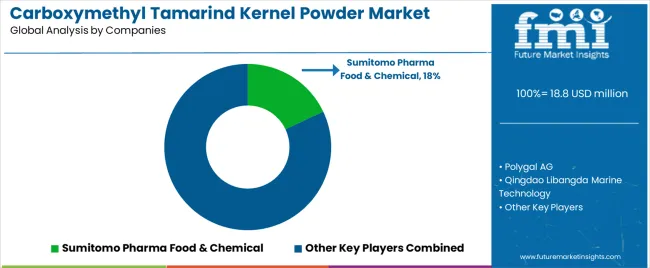
| Stakeholder | What they actually control | Typical strengths | Typical blind spots |
|---|---|---|---|
| Global brands | Distribution reach, broad product catalogs, brand recognition | Wide availability, proven performance, multi-region support | Product refresh cycles; customer dependency on brand validation |
| Technology innovators | Hydrocolloid R&D; advanced processing methods; enhanced functionality properties | Latest technologies first; attractive ROI on performance effectiveness | Service density outside core regions; scaling complexity |
| Regional specialists | Local compliance, fast delivery, nearby customer support | "Close to customer" support; pragmatic pricing; local regulations | Technology gaps; talent retention in customer service |
| Full-service providers | Complete hydrocolloid programs, application integration, performance monitoring | Lowest operational risk; comprehensive support | Service costs if overpromised; technology obsolescence |
| Niche specialists | Specialized applications, custom formulations, technical services | Win premium applications; flexible formulations | Scalability limitations; narrow market focus |
| Item | Value |
|---|---|
| Quantitative Units | USD 18.8 million |
| Solubility Type | Hot Water Soluble, Cold Water Soluble |
| Application | Food Applications, Pharmaceutical Formulations, Cosmetics and Personal Care, Industrial Applications |
| End Use | Food Processing, Pharmaceutical Manufacturing, Cosmetics Production, Industrial Facilities |
| Regions Covered | North America, Latin America, Western Europe, Eastern Europe, Asia Pacific, South Asia, Middle East & Africa |
| Countries Covered | China, India, Germany, Brazil, United States, United Kingdom, Japan, Canada, France, Australia, and 25+ additional countries |
| Key Companies Profiled | Sumitomo Pharma Food & Chemical, Polygal AG, Qingdao Libangda Marine Technology, Premcem Gums, Dabur India Ltd |
| Additional Attributes | Dollar sales by solubility type and application categories, regional adoption trends across Asia Pacific, Europe, and North America, competitive landscape with hydrocolloid manufacturers and ingredient suppliers, food processor preferences for powder effectiveness and performance control, integration with formulation platforms and quality systems, innovations in thickening technology and performance enhancement, and development of advanced hydrocolloid solutions with enhanced purity and processing optimization capabilities. |
The global carboxymethyl tamarind kernel powder market is estimated to be valued at USD 18.8 million in 2025.
The market size for the carboxymethyl tamarind kernel powder market is projected to reach USD 34.0 million by 2035.
The carboxymethyl tamarind kernel powder market is expected to grow at a 6.1% CAGR between 2025 and 2035.
The key product types in carboxymethyl tamarind kernel powder market are food applications, pharmaceutical formulations, cosmetics and personal care and industrial applications.
In terms of end use, food processing segment to command 58.0% share in the carboxymethyl tamarind kernel powder market in 2025.






Full Research Suite comprises of:
Market outlook & trends analysis
Interviews & case studies
Strategic recommendations
Vendor profiles & capabilities analysis
5-year forecasts
8 regions and 60+ country-level data splits
Market segment data splits
12 months of continuous data updates
DELIVERED AS:
PDF EXCEL ONLINE
Carboxymethyl Cellulose Market 2024-2034
Carboxymethyl Tamarind Gum (CMT) Market Size and Share Forecast Outlook 2025 to 2035
Enzymatically Hydrolyzed Carboxymethyl Cellulose Market
Tamarind Gum Derivatives Market Size and Share Forecast Outlook 2025 to 2035
Tamarind Extract Market Analysis – Trends & Forecast 2024-2034
Powdered Cellulose Market Analysis - Size, Share, and Forecast Outlook 2025 to 2035
Powdered Soft Drinks Market Size and Share Forecast Outlook 2025 to 2035
Powder Packing Machine Market Size and Share Forecast Outlook 2025 to 2035
Powder Dispenser Market Analysis by Product Type, Size, Dispensing Mode, End-use Industry, and Region through 2025 to 2035
Analysis and Growth Projections for Powder Induction and Dispersion Systems Business
Leading Providers & Market Share in Powder Packing Machines
Key Players & Market Share in Powder Dispenser Manufacturing
Powder Injection Molding Market Growth – Trends & Forecast 2025 to 2035
Powdered Fats Market – Growth, Demand & Industrial Applications
Powdered Beverage Market Outlook – Growth, Demand & Forecast 2024-2034
Powder Feed Center Market
Powder Funnels Market
Powdered Hand Soap Market
Powder Coating Guns Market
Dry Powder Inhaler Market Size and Share Forecast Outlook 2025 to 2035

Thank you!
You will receive an email from our Business Development Manager. Please be sure to check your SPAM/JUNK folder too.
Chat With
MaRIA